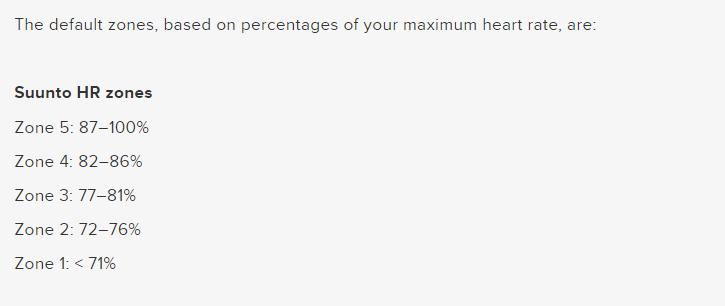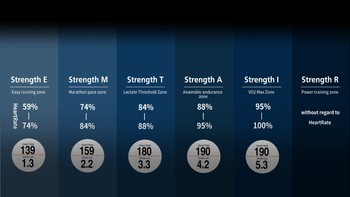HR Zones in the watch and suunto app
-
It looks like right now Sports Tracker’s web site uses the default Polar heart rate zones based on a max HR automatically guesstimated based upon your age, regardless of whatever the heart rate zone settings are on your watch and in the Suunto app. The ability to set your own maximum heart rate and customize your own zones doesn’t appear to be something that can be done on Sports Tracker’s web site, which probably explains the discrepancies. It looks like it’s a matter of getting these customizable things to play nicely with something that doesn’t allow customization at the moment.
-
@ianshowalter no,
Sportstracker has nothing to do with SA in regards to zones. Either moves count.
Suunto app and moves count read the zones directly from the watch.
-
@Dimitrios-Kanellopoulos said in HR Zones in the watch and suunto app:
Sportstracker has nothing to do with SA in regards to zones. Either moves count.
Other than it displays your HR metrics with zones which are something else you can see from your watch or from SuuntoApp…
Is there any plans for Sports-tracker web interface, is it the place which is going to be improved to display all data from SuuntoApp or is there going to be some completely new web interface? I think Sports-tracker web interface is already pretty good, but it lacks some features like these HR zones.
-
@hanta clear I sew your contusion. Sports tracker is not related to suunto or the suunto app for data. You can use it to see your data but hr zones for example will be wrong.
A new totally web should be the solution
-
@Dimitrios-Kanellopoulos
Yes, a new web page would be great.

-
@Dimitrios-Kanellopoulos sorry about bit of offtopic, but is there anything you can share with us, wen we can expect to have (beta?) web interface for SuuntoApp?
Android SuuntoApp is starting to get good shape, only thing im missing is good web interface for desktop use.
-
@hanta not at all to be honest. If it is I’ll make a plan and include the users here
-
Hi, a slightly different question in this context (I did not want to open a new topic in addition):
In the Suunto 5, the default for the HR zones is given in a completely different way than in the classic specifications such as 90-80-70% x HRmax.- Why are the recommendations of Suunto 5 so different?
- What values for the HR zones should I prefer as a recreational athlete - Suunto’s recommendations or the values given in the fitness literature?
Thanks for your tips!
-
@Armin-S said in HR Zones in the watch and suunto app:
Hi, a slightly different question in this context (I did not want to open a new topic in addition):
In the Suunto 5, the default for the HR zones is given in a completely different way than in the classic specifications such as 90-80-70% x HRmax.- Why are the recommendations of Suunto 5 so different?
- What values for the HR zones should I prefer as a recreational athlete - Suunto’s recommendations or the values given in the fitness literature?
Thanks for your tips!
Does anyone here have an explanation or suggestion?
-
@Armin-S This is a very tough question. The best way to set HR zones is to get a lactate threshold test done. In most places these are not that expensive. Otherwise you can estimate from your maximum and adjust based on RPE. I frankly do not know how the S5 guesses HR zones as I input mine manually.
-
Perhaps I can help here.
For running this was suggested for me and what I suggest to others
I5 92-97%
I4 87-92%
I3 82-87%
I2 72-82%
I1 60-72% -
I had the same question for Suunto’s default HR zones as well, it’s not just 10% 10%, it’s not HRR either.
I did a lab test to find my VO2max and the doctor told me the Lactate threshold is not been used anymore for 10 years in France, it’s too old fashion and it worth nothing for nowadays, they do a Ventilatory threshold test which can find you a VT1 and VT2 (your lactate threshold is in this zone), it’s the best zone that you can work on.
-
@Dimitrios-Kanellopoulos said in HR Zones in the watch and suunto app:
Perhaps I can help here.
For running this was suggested for me and what I suggest to others
I5 92-97%
I4 87-92%
I3 82-87%
I2 72-82%
I1 60-72%Hello DK, it’s the predefined zones in Suunto watches? or it’s just YOUR suggestions?
-
@zhang965 my suggestions. I need to find the source 1 sec
-
-
I think the question was, we wanted to know where this definition comes from, it seems it’s different than others references, it most likes only suunto’s definition
-
@zhang965 said in HR Zones in the watch and suunto app:
I had the same question as Suunto’s default HR zones as well, it’s not just 10% 10%, it’s not HRR either.
I did a lab test to find my VO2max and the doctor told me the Lactate threshold is not been used anymore for 10 years in France, it’s too old fashion and it worth nothing for nowadays, they do a Ventilatory threshold test which can find you a VT1 and VT2 (your lactate threshold is in this zone), it’s the best zone that you can work on.
I disagree with the fact that LT is worth nothing but combining with VO2 max is best. When pyruvate produced by glycolysis cannot be utilized in the TCA cycle lactate accumulates and the pH can drop due to hydrogen ion production. The ability to use lactate and prevent its accumulation will vary depending on the type of muscle fibers where endurance athletes will have a much higher number of slow twitch fibers and sprinters, fast twitch fibers. The lactate threshold will change depending on fitness as well.
-
@zhang965 said in HR Zones in the watch and suunto app:

Thanks for the link. Exactly this information I was looking for! Very nice that there is this help here in the forum. Thanks again

-
@Brad_Olwin said in HR Zones in the watch and suunto app:
@zhang965 said in HR Zones in the watch and suunto app:
I had the same question as Suunto’s default HR zones as well, it’s not just 10% 10%, it’s not HRR either.
I did a lab test to find my VO2max and the doctor told me the Lactate threshold is not been used anymore for 10 years in France, it’s too old fashion and it worth nothing for nowadays, they do a Ventilatory threshold test which can find you a VT1 and VT2 (your lactate threshold is in this zone), it’s the best zone that you can work on.
I disagree with the fact that LT is worth nothing but combining with VO2 max is best. When pyruvate produced by glycolysis cannot be utilized in the TCA cycle lactate accumulates and the pH can drop due to hydrogen ion production. The ability to use lactate and prevent its accumulation will vary depending on the type of muscle fibers where endurance athletes will have a much higher number of slow twitch fibers and sprinters, fast twitch fibers. The lactate threshold will change depending on fitness as well.
OK, then do a lactate threshold test
-
@Dimitrios-Kanellopoulos said in HR Zones in the watch and suunto app:
@zhang965 my suggestions. I need to find the source 1 sec
I show you an example from euh… GARMIN!
It’s funny because… this piece of information only can be found in Garmin TW/HK, it quite closes to suunto’s proposal.

